Have you ever thought to clean houseplants in your home? If you’re like me, the answer is no.
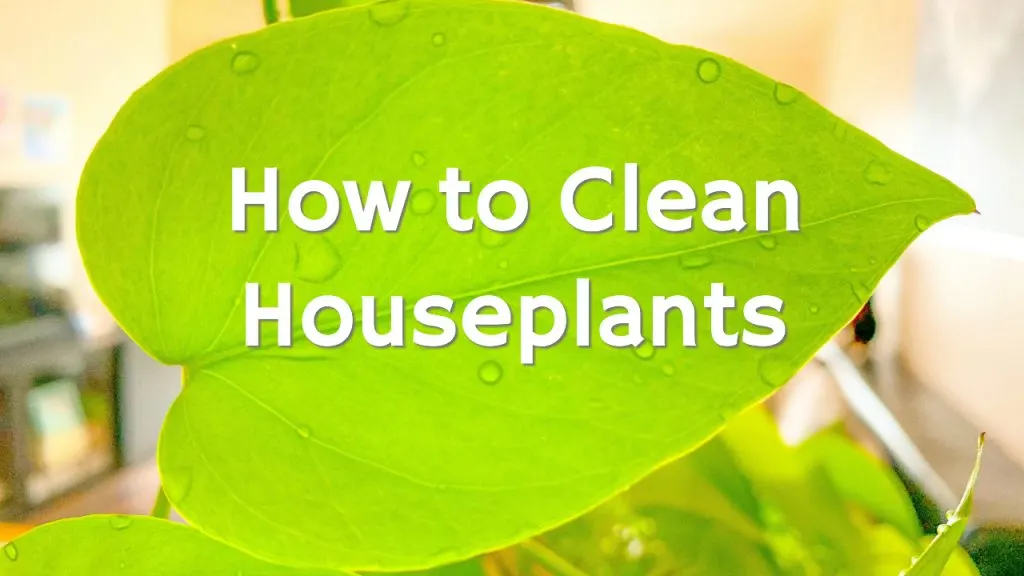
Until one day you happen to catch a glimpse of you indoor plant’s leaves and you realize that there is such a layer of dust on them that you’re shocked. (Maybe that’s just me?!?)
I don’t enjoy cleaning my house. And I’m certainly not looking for one more thing to do while cleaning my home. However, I’ll gladly add time to clean houseplants to my list.
Here’s why.
Why You Want to Clean Houseplants
Okay, plants grow in dirt. Therefore, they should stay dirty. Right?
Wrong.
Plants grow in dirt outside. Where they are exposed to the elements, such as wind, rain and animals. Comparing plants growing indoors in soil to plants growing outdoors is two completely different things.
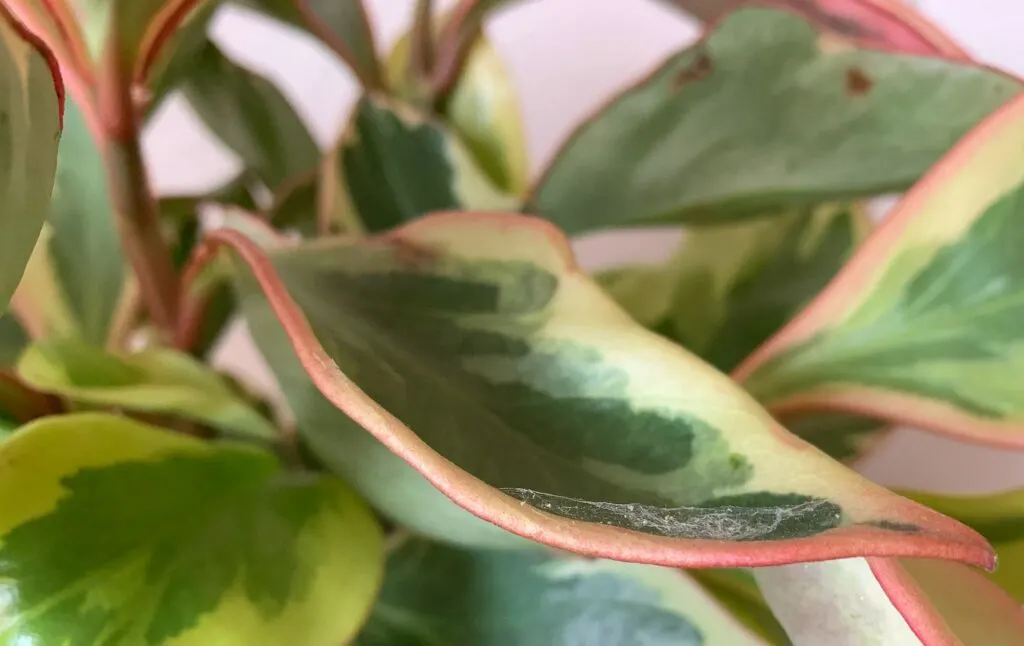
Because indoor plants never get a chance to receive a healthy bath of rainwater rushing down their leaves. Or whip back in forth in a gust of wind, with debris flying off of their leaves. Or have birds, squirrels or bees land on their leaves, brushing off dirt and dust as they climb on the plants.
Nope. Indoor plants have none of those natural ways of staying clean. Which is why it’s so important for you, as a plant mom or plant dad, to clean houseplants for them.
Houseplants need to stay clean for these two reasons:
Dirty Plant Leaves Can Kill a Plant
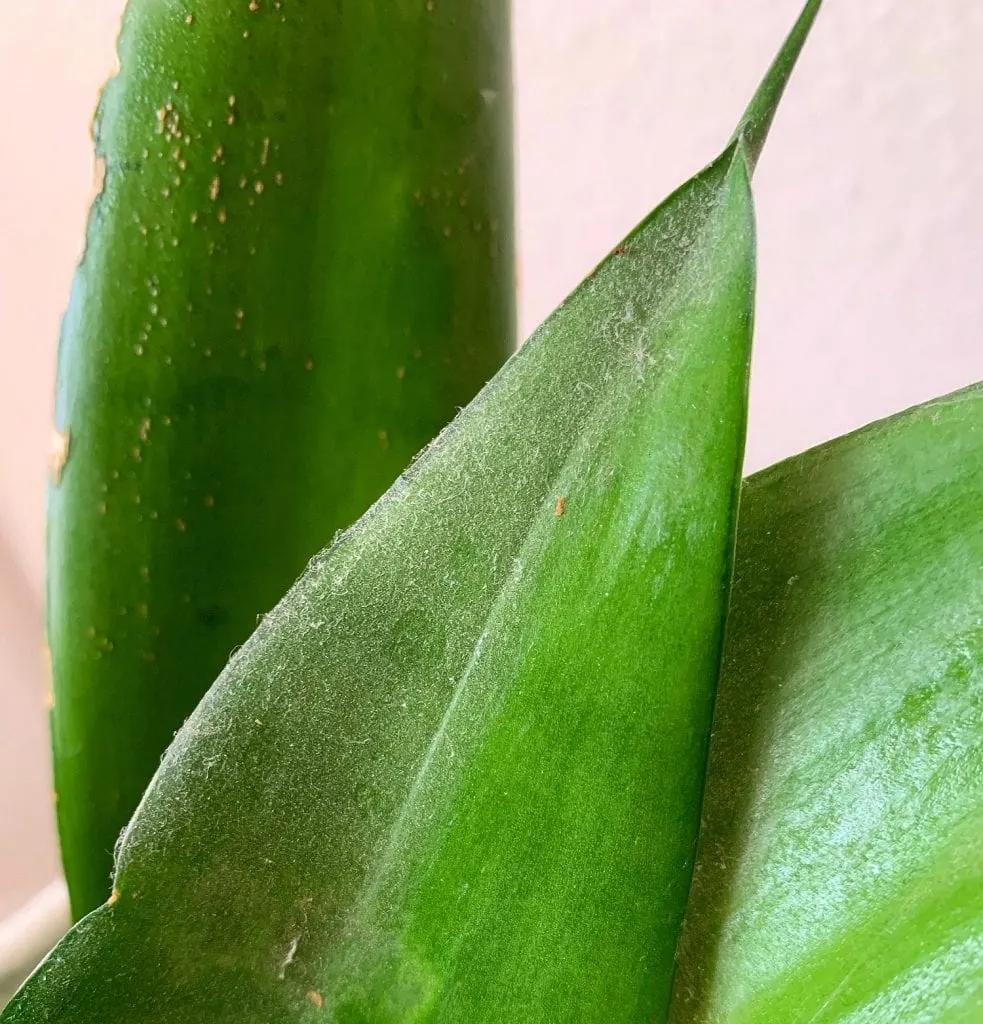
Dirt and dust doesn’t just exist on top of the leaves with no repercussions. Instead, those tiny particles clog the pores of the plant. Which is a problem because a plant’s pores are where it gets sunshine. And sunshine fuels your houseplant through photosynthesis.
So reduced sun equals reduced food. Which means your houseplants are struggling every day.
Dirty Plants Reduce Air Purifying
Chances are, you’ve added a houseplant in your home for it’s natural air purifying properties. So you don’t want to reduce the air purification in your home.
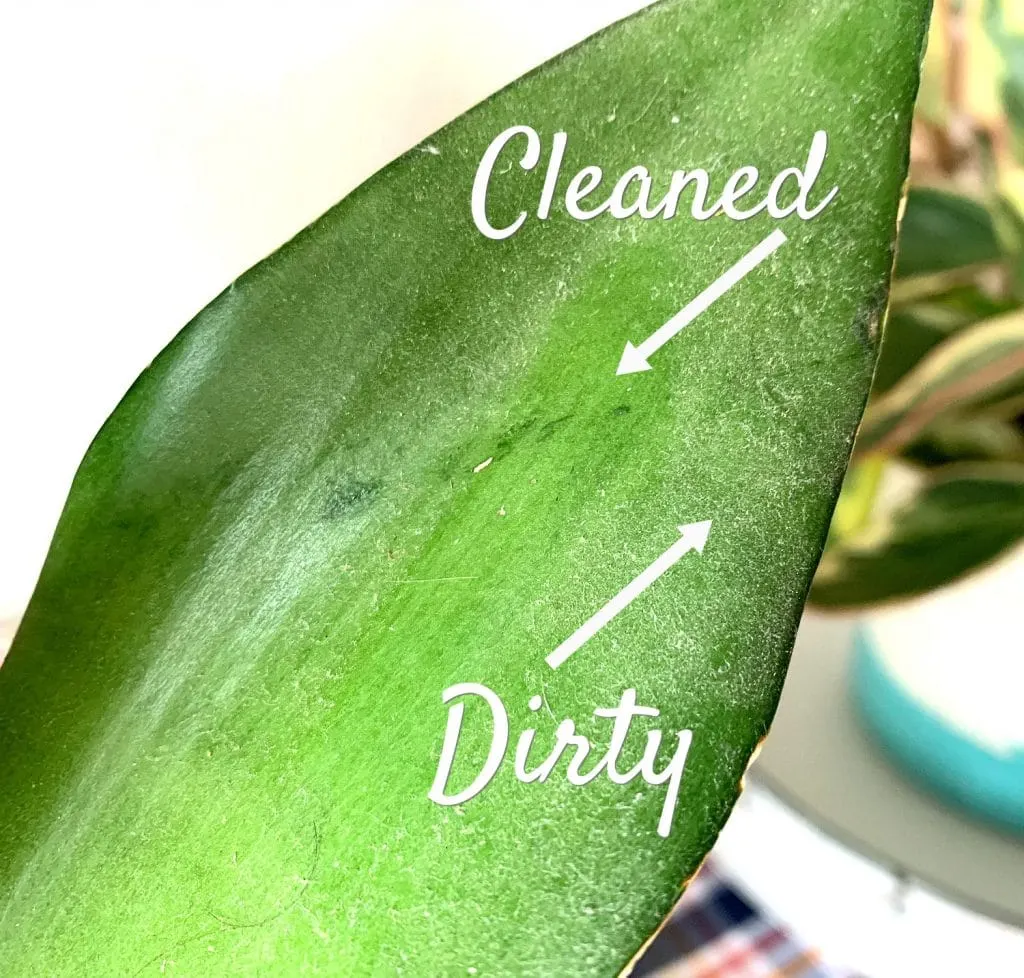
Just like dust and dirt can clog an indoor plant’s pores from getting sunshine, it also means there is not as much air flow into the plant’s pores. And one of the ways that houseplants clean indoor air is by air flow through the plant’s leaves.
How Often You Should Clean Houseplants
Just like with dusting your home or cleaning the floors, it’s hard to say exactly how often you should clean houseplants.
If you live on a dusty road, or do a lot of home renovation and DIY with debris in the air, you will need to clean more often.
Regardless of where you live, the way to tell if a houseplant’s leaves need to be cleaned is to:
- Look at the plant’s leaves to see if dust and debris have accumulated
- Run your finger along the plant’s leaves to see if dust comes off
Depending on what type of houseplant you have will depend on what method is best for deciding when it’s time to clean your indoor plants.
How to Clean Houseplants
The way you clean houseplants will depend on three different factors:
- Can the houseplant be moved?
- Does the plant have lots of small leaves, or a few big ones?
- Are the plant’s leaves fuzzy?
Depending on your answer, you’ll want to use one of the following methods:
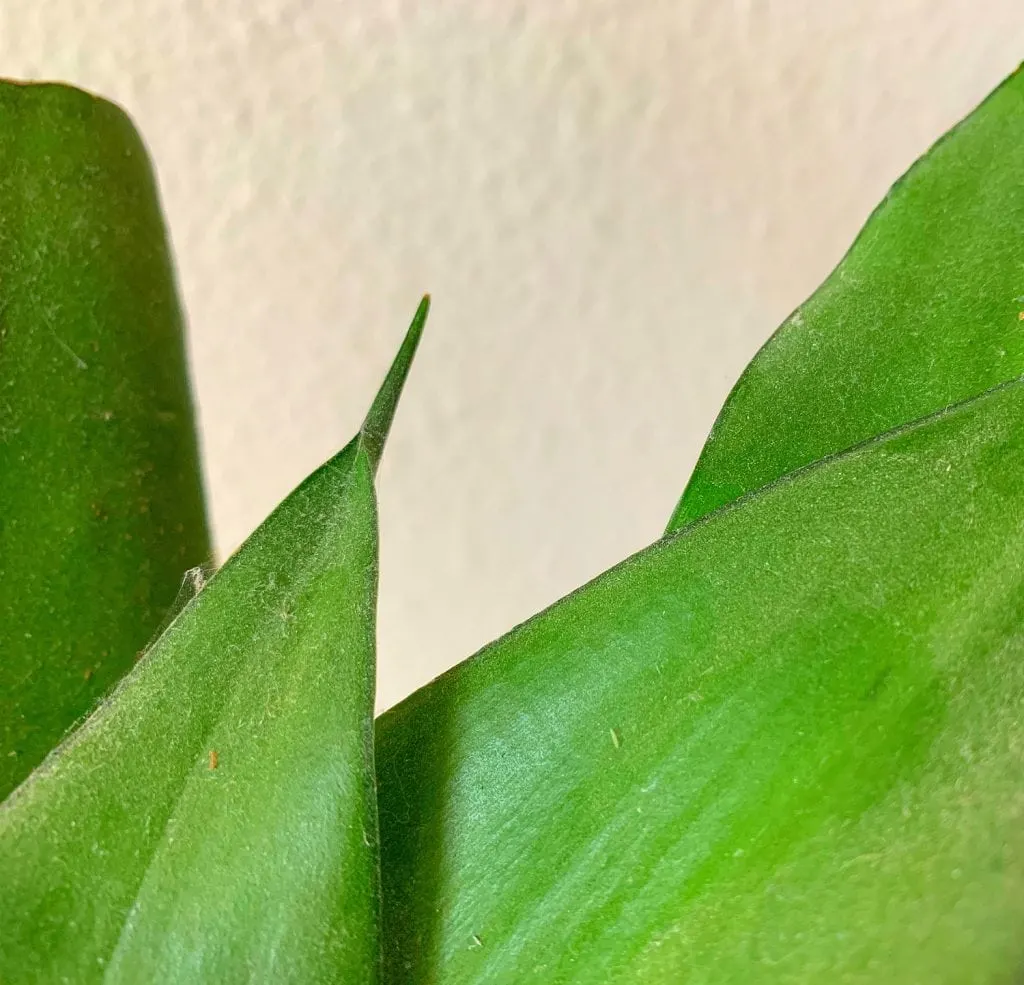
Showering Your Houseplants
If your plant is easily moved, you can bring it to the kitchen sink, shower or bathtub for an easy bath.
- Hosing off the leaves with a spray attachment is a quick and easy way to remove dust and debris. Plus, you’ll get to water your plants at the same time.
- Use lukewarm water. Hot or cold water can damage your plants, plus cause spotting on the leaves.
- A gentle spray of water is fine. No need to use a powerful spray that might damage the leaves and spray potting soil out of the pot.
- Allow your plants to dry in the shower or bathtub if possible. Otherwise you could be carrying a dripping houseplant through your home, which adds more work for you.
- If you are letting your plants dry in a bathroom or kitchen that has different light levels than the plant is used to, be sure that it won’t damage your plant. For example, a window with the sun beating in on the plants in a tub could be damaging if you are washing low light houseplants, such as Chinese Evergreen, that shouldn’t be in direct sun.
Wiping Down Leaves
For big plants that can’t be moved to a kitchen sink or into a shower, you’ll want to wipe down the plant’s leaves individually.
I also choose this method for my houseplants that have thick, sturdy, single leaves that are simple to wipe down.
For instance, it’s easier for me to wipe down a Snake Plant’s leaves, rather than try to hose it off. There aren’t that many leaves and I can do it in one swipe. However, if I was trying to wipe down a ZZ plant’s leaves, it would take forever because each stem has a lot of different little leaves on them.
- Wipe down the leaves with a wet rag. It can be a disposable paper towel or a reusable cloth. You could also use a dusting glove so that you can grip each plant leaf with ease.
- Hold the leaf in one hand for support, and wipe down the leaf with your other hand.
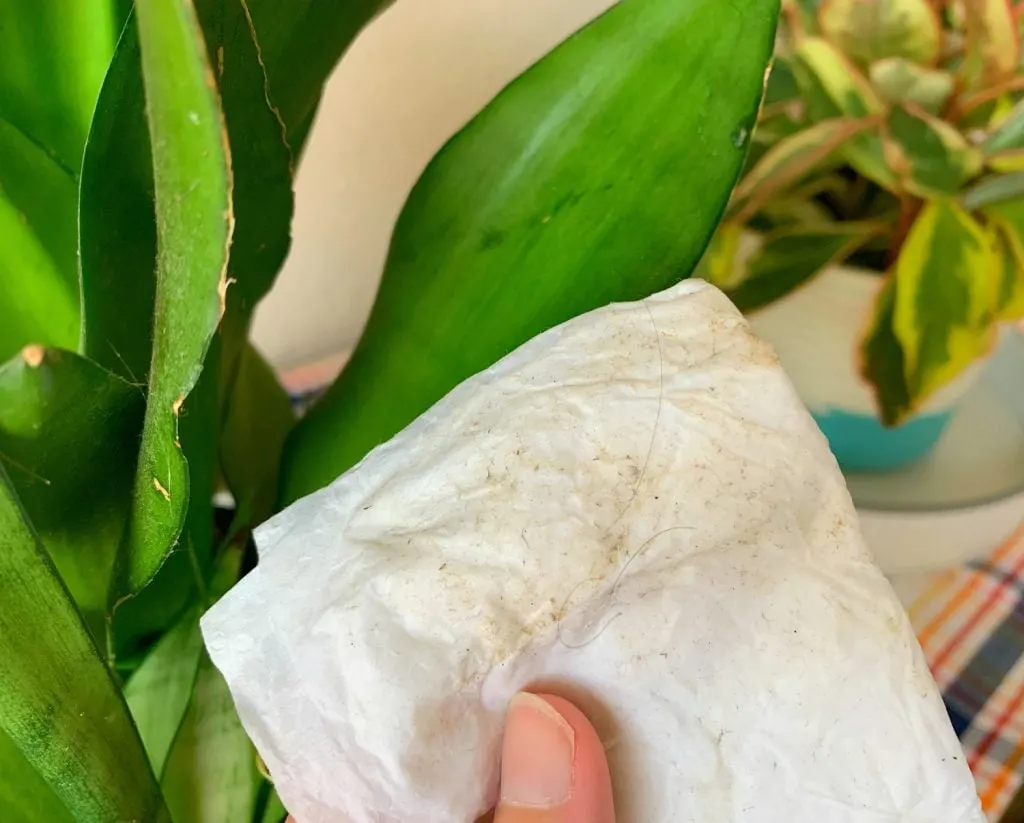
- If you want to spray the plant first with a light mist of water, then that will speed up the process. Simply wet all of the plant’s leaves. Then go through with a rag and wipe them down.
- For extra cleaning power, spray your plants with a mixture of water and just one or two drops of dish soap. This will break through grease, grime and caked on dirt faster. However, you need to make sure to remove all of the water from the plant’s leaves, so that there is no lingering soap residue.
Sticky or Fuzzy Leaves
These types of plants either don’t like their leaves getting wet, or wetting them won’t make much of a difference in removing dust. An African violet is an example of this type of plant.
In this case, you’ll want to gently brush off the dust and debris.
- Using a small paintbrush, gently dust off the particles on each plant’s leaves. Yes, it can be tedious and time consuming. But you’re plant will love you for it!
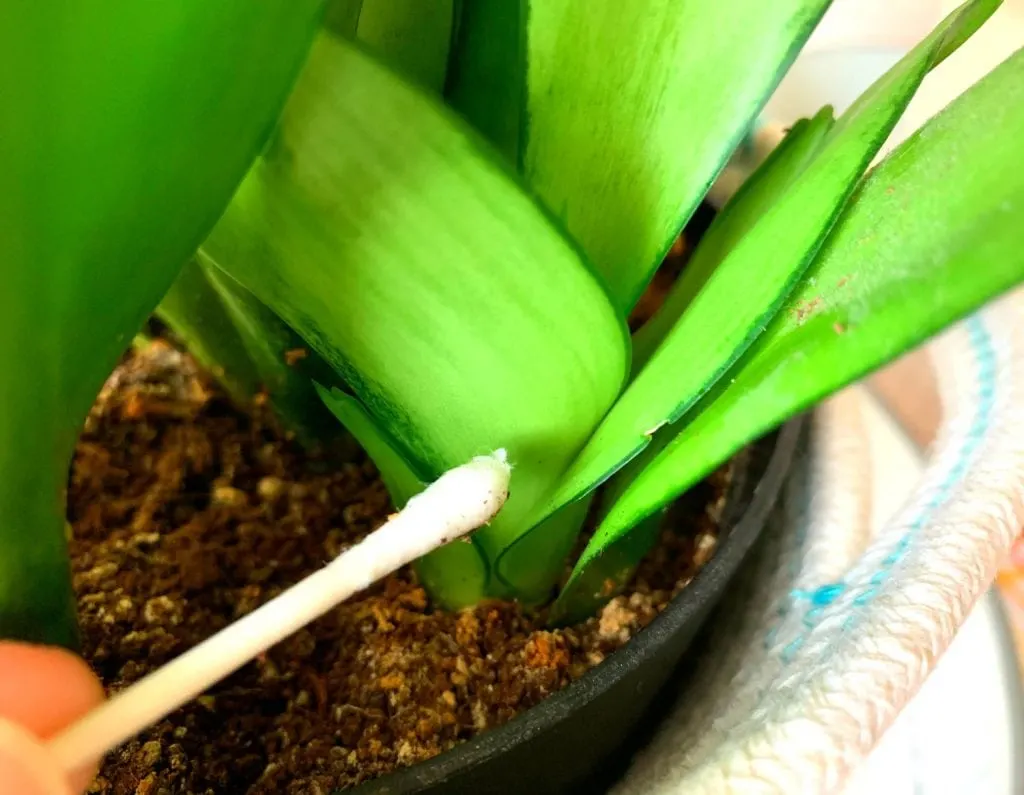
- A cotton swab does a great job at gently removing dust and dirt, too. Especially in-between leaves of any type of houseplant. Cotton swabs are great for cleaning delicate little leaves, such as those on a succulent.
- For plants with leaves that are hard to clean – such as cacti – consider using a can of compressed air. A strong blast of air can dislodge the dust from prickly plants easily without hurting you!
See me washing my houseplants (and look at how dirty they were!) in my video below:
Should I Shine Houseplant Leaves?
I’ll admit, the first time I ever heard about shining a houseplant’s leaves I was confused. Why would I take the time to do that, and what is the purpose?
After learning more about shining houseplants leaves, I still feel the same way. It’s not necessary and quite honestly, I think it can hurt the plant more than help it.
After all, why do you need to shine the leaves? It’s not for the health of the plant. It’s only for aesthetic reasons for you.
Unless you really love having bright shiny leaves that seem more plastic than real, there’s no need to shine houseplant leaves. If they are kept cleaned, they shouldn’t be too dull, anyway.
There are plenty of resources of how to shine leaves with milk, mayonnaise, coconut oil and more food based products. Just keep in mind, these items can clog a plant’s pores.
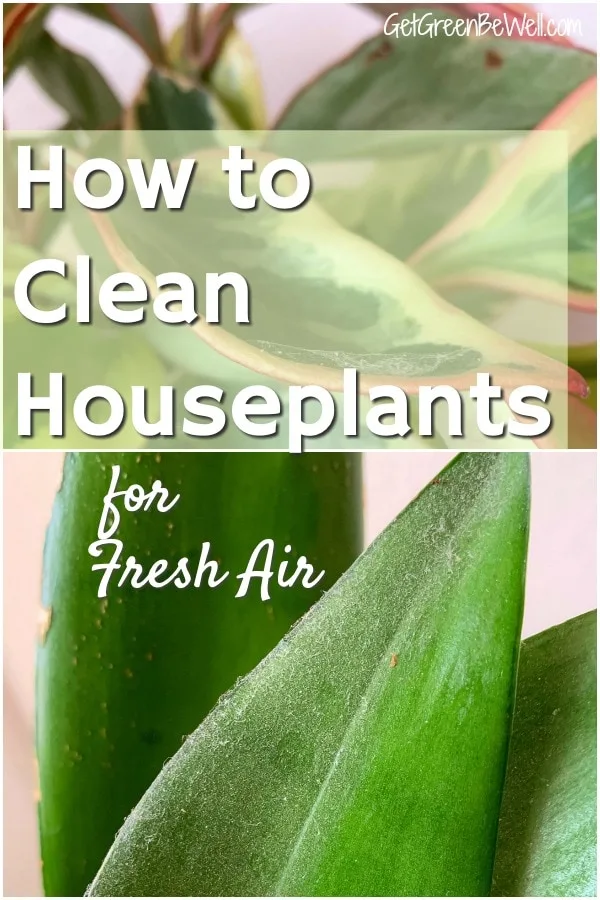
More Houseplant Resources
If you love houseplants as much as I do, you’ll want to check out these helpful tips and shopping guides:
- Best Plants for the Bedroom
- How Houseplants Purify the Air
- Potting Soil and Fungus Gnats
- How to Keep Plants Alive While on Vacation
- DIY a Trash Can into a Flower Pot Planter

Joanna
Monday 15th of February 2021
Thank you and I appreciate your knowledge.
Kimberly Button
Monday 15th of February 2021
Thank you Joanna :)
Best Plants for Cleaning Indoor Air | HealthyGreenSavvy
Tuesday 5th of March 2019
[…] are tips for cleaning houseplants so they can do their job of cleaning your […]